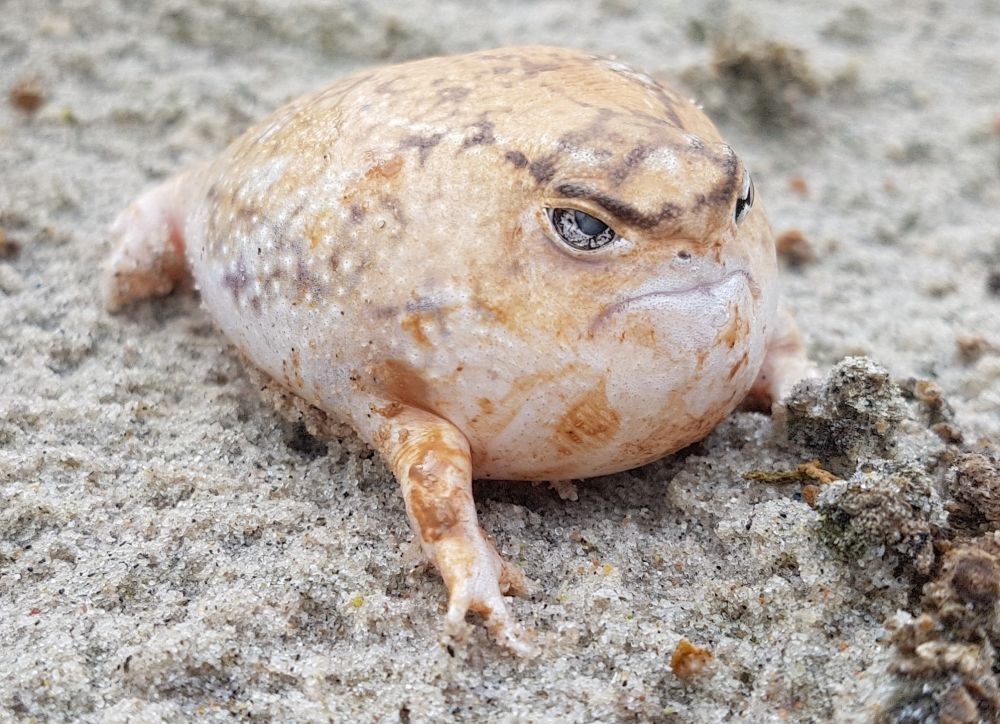Get ready to meet your new favorite amphibian, because today we’d like to discuss the desert rain frog, Breviceps macrops. Also known as the marshmallow frog (for it is about the size of a marshmallow) these mini critters have evolved to thrive in desert ecosystems, and they have some pretty bizarre adaptations to show for it.
What do desert rain frogs eat?
In a place that only gets around 7 centimeters (2.8 inches) of rain a year, desert rain frogs have to get creative in order to get as much moisture as possible. That’s why they have such a taste for termites, which, as luck would have it, are packed with around 75 percent water. Desert rain frogs can eat as many as 100 termites in a single sitting, but that does depend on whether or not they can catch them first.
As this clip from episode three of the BBC’s A Perfect Planet shows, it doesn’t always go very well. Unable to hop, even small obstacles can represent quite the struggle. Fortunately, they have a nifty adaptation that helps them to scoop up moisture along the way.
It almost waddles across the sand like one of those wind-up swimming frogs.
Sarah Walsh
“They have a unique belly patch of very thin and absorbent skin,” Assistant Producer at BBC Studios Natural History Unit Sarah Walsh told IFLScience when the A Perfect Planet episode came out. “This means when they find wet sand, they can just touch their belly to it and it will absorb the moisture through their skin.”
A smart move for a rain frog in such an arid environment, but they’ve still got to get a wiggle on if they’re to finish their business and steer clear of predators all before the Sun comes up and it’s time to go subterranean again.

Desert rain frogs puff up like balloons when threatened.
Where do desert rain frogs live?
Found in dunes across South Africa, they spend 90 percent of their time hidden beneath the sand. As night falls, all manner of critters emerge to make use of the environment while things are cooler, and this is when it’s the desert rain frog’s time to shine.
These little frogs are really the most patient creatures I have met.
Sarah Walsh
They can travel as far as 38 meters (124 feet) in a single night, which is about the equivalent of an average human walking a mile. Doesn’t seem like much until you see the incredible inefficiency of the desert rain frog waddle.
“Its legs are paddle-like, it almost waddles across the sand like one of those wind-up swimming frogs,” said Walsh. “Its toes are also webbed, which although common for the general frog as we know it is actually very unique to this type of frog.”
Where do baby desert rain frogs come from?
You may know desert rain frogs for their characteristic scream, and their ability to make a lot of noise is crucial if they’re to find a mate. Females follow the calls of males, and when they meet, she’ll wear her new partner like a little backpack.
It takes time, effort, and patience for these frogs to find love in the vast landscape, but making baby desert rain frogs has never been more crucial. Desert rain frogs have been suffering from widespread drought since 2015, some of the worst in history for the region. Finding water is hard enough for these animals when conditions are favorable, and the ever-changing weather is bringing them to the brink.
A tough life, then, for a little frog, but one we can all stand to learn something from.
“Patience is a virtue, these little frogs are really the most patient creatures I have met,” said Walsh. “They patiently wait underground for those foggy nights where they might be able to get some hydration and then patiently call out and hope they find a mate. The population is small and their habitat very vast, they really have to have the patience and hope that they get lucky… literally.”
Source Link: The Marshmallow-Sized Desert Rain Frog Can Waddle 38 Meters In A Night